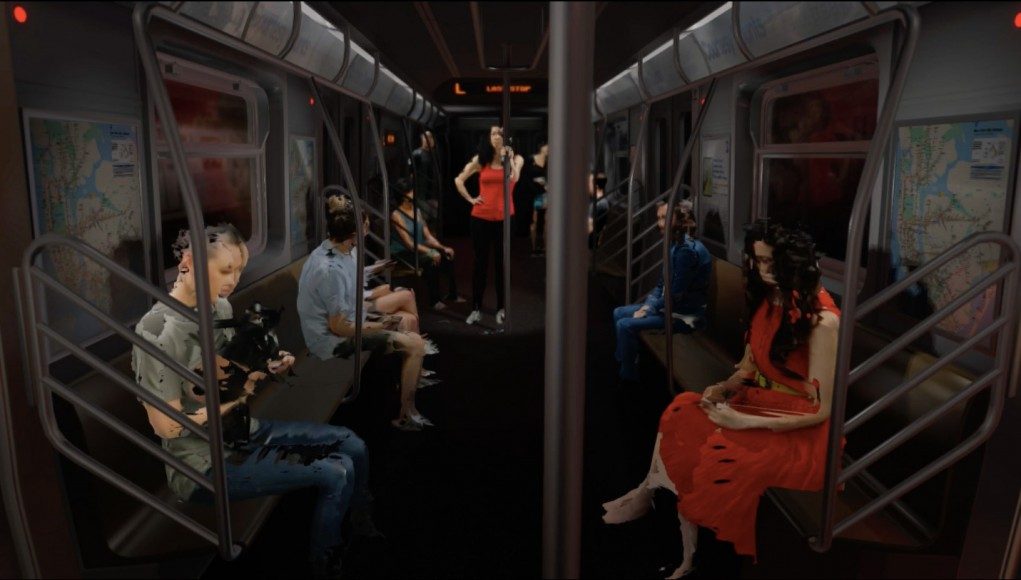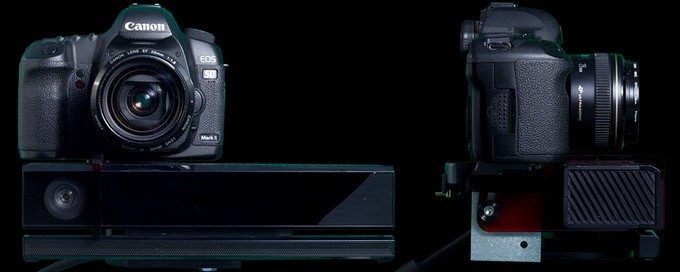Blackout is a narrative virtual reality experience from creative studio Specular which merges a real-time game environment with depth-captured subjects, set in New York City’s subway. Having completed principal photography, the studio’s Kickstarter campaign aims to finish production for deployment on desktop and mobile VR platforms.
A packed subway car filled with mid morning commuters screeches to a halt.
A terse mood settles as passengers become impatient. A muffled voice –
unintelligible and nervous – is interrupted by a deafening electric surge.
One by one the overhead lights burst. The carriage goes dark. Indistinct murmurs
are replaced by a palpable silence.
You glance up from your seat into the darkness at the softly illuminated faces of
strangers surrounding you.
A stream of consciousness erupts …
As far as storytelling goes, this is surely a unique way to go about it. But Blackout is experimenting with capture technology equally as much as the narrative structure. Utilizing DepthKit, a bespoke depth and video capture system of Specular’s design, the studio is capturing human performances which are placed in 3D space within the real-time virtual environment.
Blackout is a narrative virtual reality experience from creative studio Specular which merges a real-time game environment with depth-captured subjects, set in New York City’s subway. Having completed principal photography, the studio’s Kickstarter campaign aims to finish production for deployment on desktop and mobile VR platforms.
A packed subway car filled with mid morning commuters screeches to a halt.
A terse mood settles as passengers become impatient. A muffled voice –
unintelligible and nervous – is interrupted by a deafening electric surge.
One by one the overhead lights burst. The carriage goes dark. Indistinct murmurs
are replaced by a palpable silence.
You glance up from your seat into the darkness at the softly illuminated faces of
strangers surrounding you.
A stream of consciousness erupts …
As far as storytelling goes, this is surely a unique way to go about it. But Blackout is experimenting with capture technology equally as much as the narrative structure. Utilizing DepthKit, a bespoke depth and video capture system of Specular’s design, the studio is capturing human performances which are placed in 3D space within the real-time virtual environment.
“…the new DepthKit is completely rebuilt for live action virtual reality in conjunction with
the Unity game engine,” the company says.
We saw something similar used to impressive effect from Specular’s earlier CLOUDS, a virtual reality documentary which strung together more than 10 hours of interviews and visualizations from artists, hackers, and designers, all seen as point-cloud-like blips of data zipping and zooming around in a void of virtual infinity.
See Also: CLOUDS is an Immersive VR Documentary Combining CG Data Visualization & Depth-mapped Interviews
Blackout, on the other hand, aims for a more realistic style and setting, and glimpses elements of both fiction and non-fiction as viewers explore the inner thoughts of real New Yorkers.
Having completed principal photography, Specular has taken Blackout to Kickstarter to raise funds to bring the experience to completion, promising that it will be available on desktop and mobile VR platforms.
The company says the real-time desktop version will be compatible with the Oculus Rift and HTC Vive, while the mobile version will take the form of a 360 degree video for wide distribution on Gear VR and Google Cardboard.
Among lesser rewards like a production journal and a 3D animated lenticular postcard, the mobile VR version of the experience starts at $20, while the desktop version starts at $30.
If you fancy yourself an artist, you can leave your mark on the experience itself with the $25 tier which will have your own graffiti tag placed inside the subway car where anyone can see it (along with the prior pledge rewards). Not enough? The a $950 tier (limited to 10 backers) gives you the option to be one of the strangers on the subway, complete with your own story.
If you’re more interested in experimenting with depth-captured storytelling alongside Specular, the company is offering up a DepthKit DIY package at the $290 tier which will provide the hardware and software necessary to combine a Kinect 2 and DSLR into a depth-capture rig, including a Unity plugin to bring the data into VR environments.








